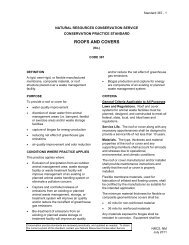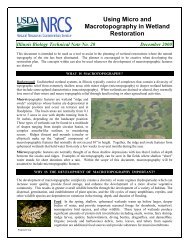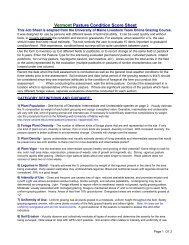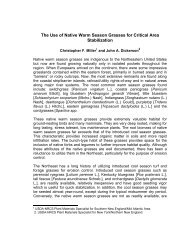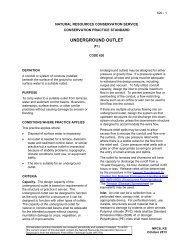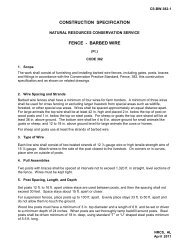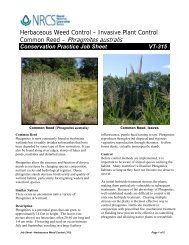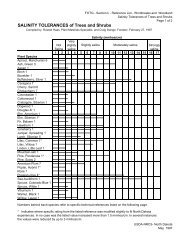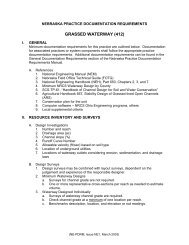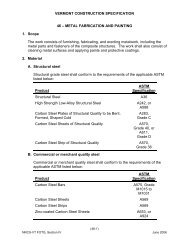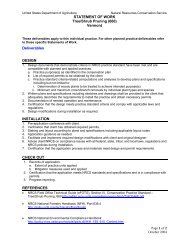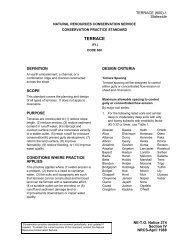estimating sheet and rill erosion - Field Office Technical Guide
estimating sheet and rill erosion - Field Office Technical Guide
estimating sheet and rill erosion - Field Office Technical Guide
Create successful ePaper yourself
Turn your PDF publications into a flip-book with our unique Google optimized e-Paper software.
SUBSECTION D-2 WATER EROSION – PAGE 7<br />
<strong>and</strong> maintains the database components located on the official RUSLE2 website located at<br />
the following website:<br />
http://fargo.nserl.purdue.edu/RUSLE2_dataweb/RUSLE2_Index.htm.<br />
These components comprise the Official NRCS RUSLE2 Database. Databases developed<br />
using these components are the only databases to be used for official purposes by NRCS<br />
field office employees.<br />
Localized RUSLE2 databases have been developed by the State Agronomist <strong>and</strong> are<br />
located on the O:\drive (O:\RUSLE2\NRD Databases). The appropriate database for your<br />
local field office will be used.<br />
Guidance for use of RUSLE2<br />
For NRCS users, basic instructions for using the RUSLE2 model are also located on the<br />
O:\drive (O:\RUSLE2\Using RUSLE2). Outside users can request instructions form the<br />
State Agronomist. These PowerPoint Presentations include a general overview of the<br />
database <strong>and</strong> instructions for getting started, instructions for using RUSLE2 to do soil loss<br />
calculations, instructions for building <strong>and</strong> saving managements, <strong>and</strong> a presentation on<br />
database management.<br />
Developing RUSLE2 Managements<br />
To ensure consistency in the application of the RUSLE2 model across the state, a st<strong>and</strong>ard<br />
set of parameters has been developed for each Crop Management Zone in the state except<br />
for CMZ 16 which was combined with CMZ 24 (refer to Figure 1: RUSLE2 Crop<br />
Management Zones). The parameters include guidance on planting dates, harvest dates,<br />
yields <strong>and</strong> monthly irrigation amounts for common crops (refer to the parameter guidance<br />
below). These parameters shall be used for developing all RUSLE2 managements.<br />
To develop a RUSLE2 management start with a no-till management for the desired crop<br />
rotation using the appropriate planting dates, harvest dates, yields <strong>and</strong>, if needed, irrigation<br />
water amounts (refer to RUSLE2 parameters for the appropriate CMZ). Next add the<br />
tillage operations normally used for the crop management system being modeled.<br />
Common tillage operations <strong>and</strong> their relative intensity in terms of residue burial <strong>and</strong> the<br />
soil tillage intensity rating (STIR) are listed in Table 2.<br />
Once a management has been developed based on st<strong>and</strong>ard parameters for the appropriate<br />
CMZ, insert the management in a Profile in RUSLE2 for the desired location <strong>and</strong> soil map<br />
unit with the appropriate slope <strong>and</strong> slope length to determine if the target soil loss has been<br />
achieved. For a Resource Management System (RMS) or basic conservation system (BCS)<br />
this would be “T” whereas for an alternative conservation system (ACS) this would be<br />
greater than “T”.<br />
Table 1 includes slope lengths to be used in RUSLE2 calculations when field<br />
measurements are not taken. If the percent slope for the map unit falls within the specified<br />
range the slope length must fall within the corresponding range. A recommended slope<br />
length is listed for each slope group. Slope lengths based on actual field measurements are<br />
preferred.<br />
NE-T.G. Notice 585<br />
SECTION I<br />
NRCS-MAY 2007



